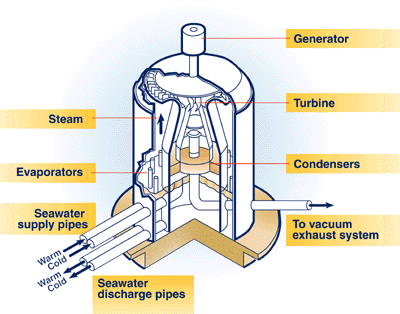ocean thermal energy conversion

Diagram of the open-cycle ocean thermal energy conversion system at Keahole Point, Hawaii, which, in May 1993, produced a record-breaking 50,000 watts of electricity during a net power-producing experiment. Credit: NREL.
Ocean thermal energy conversion is the process or technologies for producing energy by harnessing the temperature differences (thermal gradients) between ocean surface waters and that of ocean depths, which may be as much as 20°C. Warm surface water is pumped through an evaporator containing a working fluid, such as ammonia, in a closed Rankine-cycle system. The vaporized fluid drives a turbine/generator. Cold water from deep below the surface is used to condense the working fluid.
Open-cycle OTEC technologies use ocean water itself as the working fluid. Closed-cycle OTEC systems circulate a working fluid in a closed loop. A working 10 kilowatt, closed-cycle prototype was developed by the Pacific International Center for High Technology Research in Hawaii with U.S. Department of Energy funding, but was not commercialized.
The oceans are a vast renewable resource, with the potential to help us produce billions of watts of electric power. This potential is estimated to be about 1013 watts of baseload power generation, according to some experts. The cold, deep seawater used in the OTEC process is also rich in nutrients, and it can be used to culture both marine organisms and plant life near the shore or on land.
